Module 5 Cartoons复习课件 外研版英语八年级下册(共32张PPT)
文档属性
| 名称 | Module 5 Cartoons复习课件 外研版英语八年级下册(共32张PPT) | 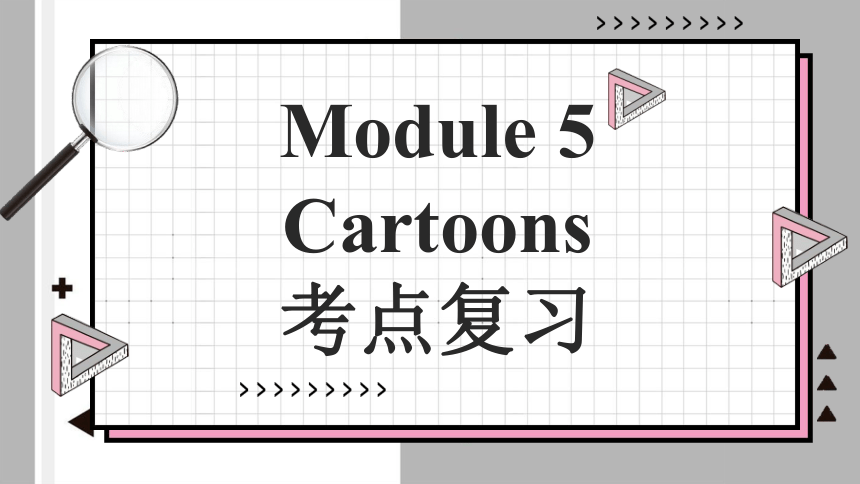 | |
| 格式 | pptx | ||
| 文件大小 | 6.6MB | ||
| 资源类型 | 教案 | ||
| 版本资源 | 外研版 | ||
| 科目 | 英语 | ||
| 更新时间 | 2023-07-04 08:44:27 | ||
图片预览

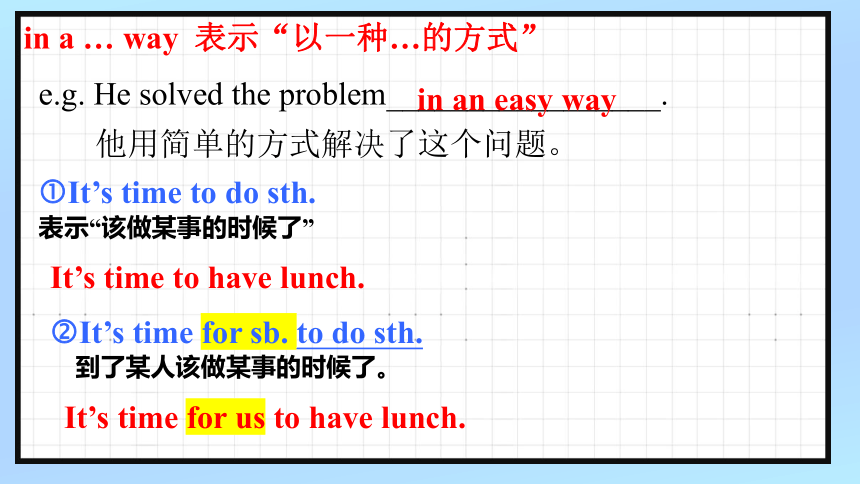
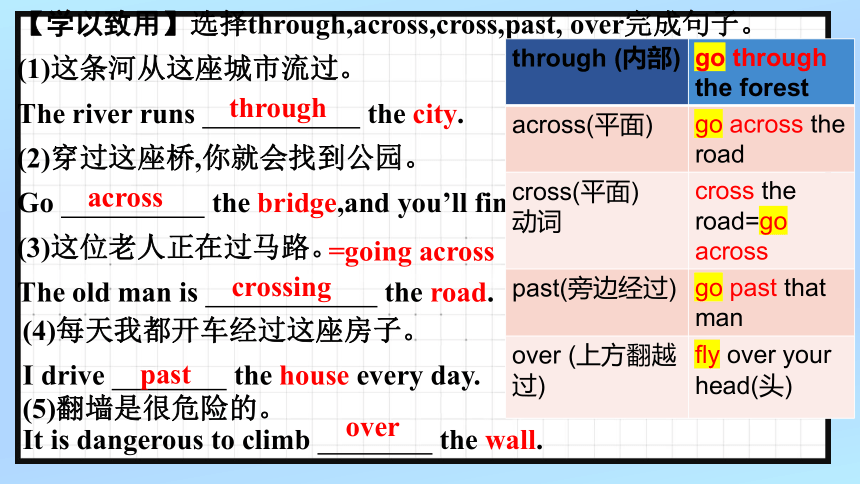
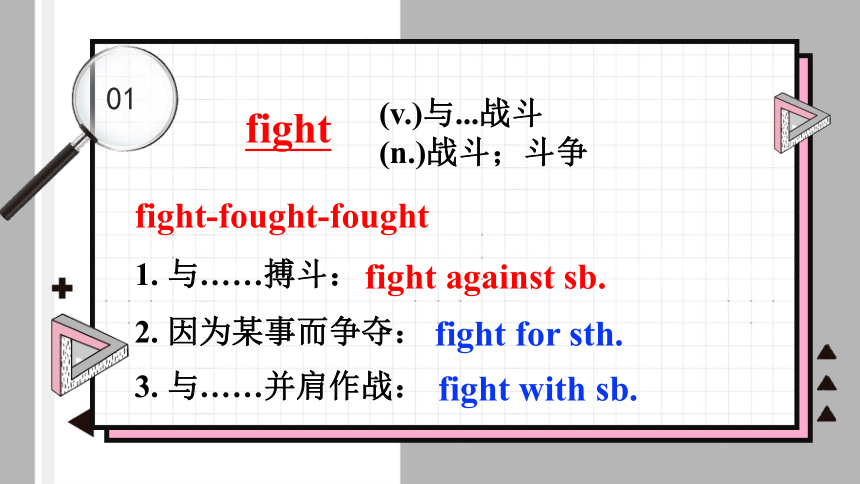

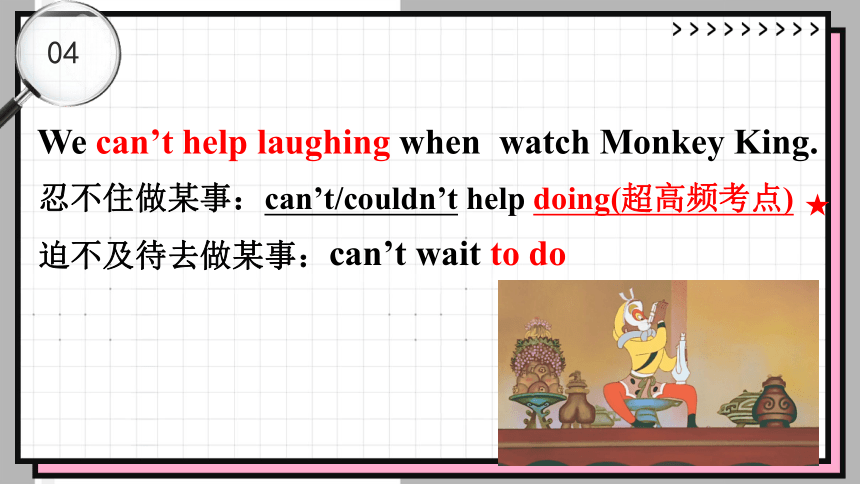
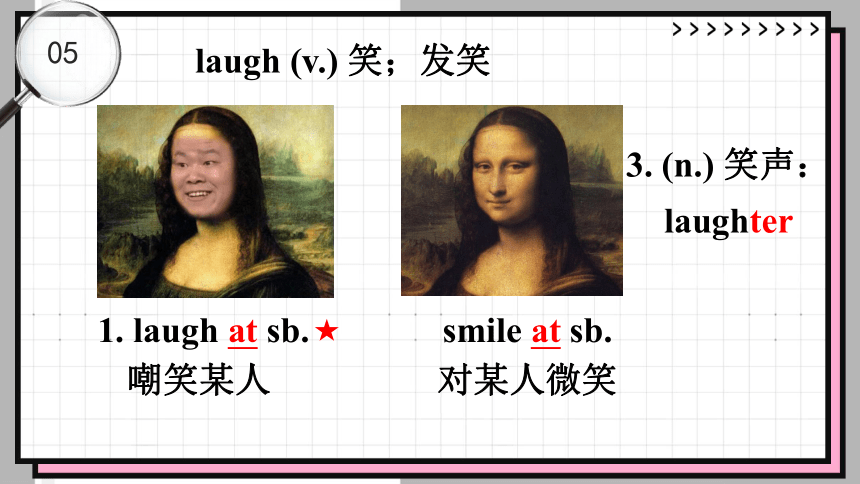
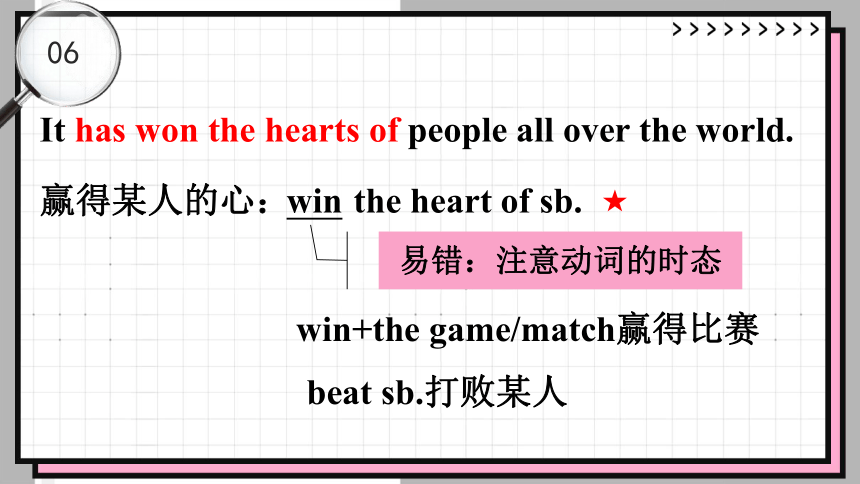
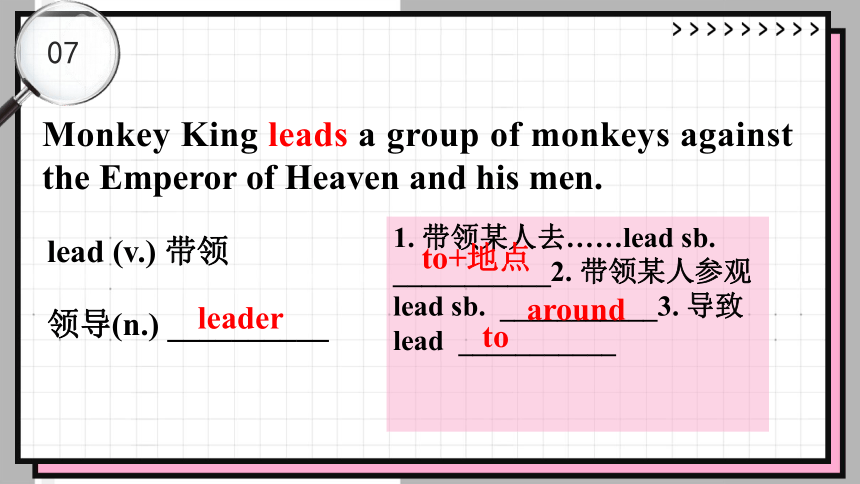

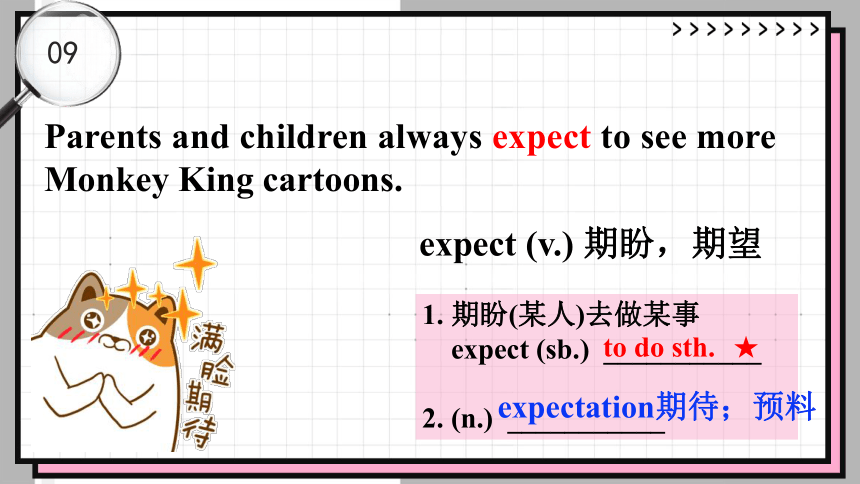
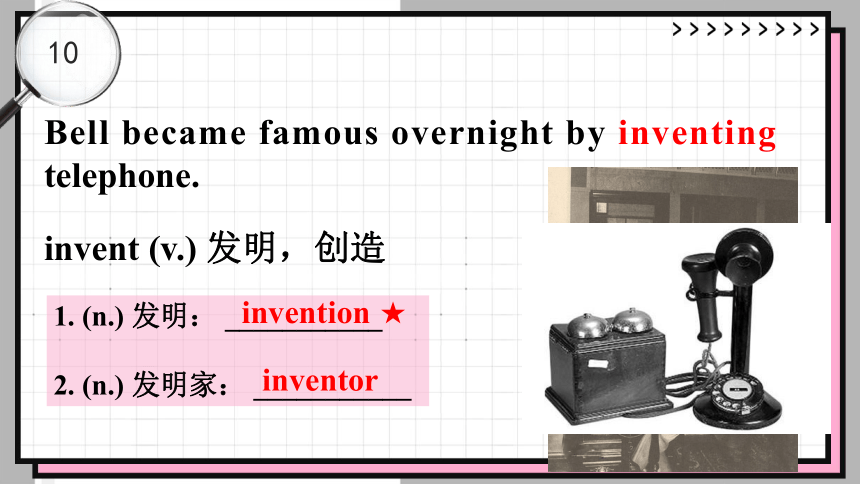
文档简介
(共32张PPT)
Module 5
Cartoons
考点复习
in a … way 表示“以一种…的方式”
e.g. He solved the problem_________________.
他用简单的方式解决了这个问题。
in an easy way
It’s time to do sth.
表示“该做某事的时候了”
It’s time to have lunch.
It’s time for sb. to do sth.
到了某人该做某事的时候了。
It’s time for us to have lunch.
【学以致用】选择through,across,cross,past, over完成句子。
(1)这条河从这座城市流过。
The river runs the city.
(2)穿过这座桥,你就会找到公园。
Go the bridge,and you’ll find the park.
(3)这位老人正在过马路。
The old man is the road.
crossing
across
through
(4)每天我都开车经过这座房子。
I drive the house every day.
(5)翻墙是很危险的。
It is dangerous to climb the wall.
over
past
=going across
through (内部) go through the forest
across(平面) go across the road
cross(平面) 动词 cross the road=go across
past(旁边经过) go past that man
over (上方翻越过) fly over your head(头)
01
fight
(v.)与...战斗
(n.)战斗;斗争
fight-fought-fought
1. 与……搏斗:
2. 因为某事而争夺:
3. 与……并肩作战:
fight against sb.
fight for sth.
fight with sb.
We like watching humorous cartoons.
humorous (adj.)幽默的;滑稽的
humor (n.)幽默;滑稽
a sense of humor幽默感
03
考点:名词变形容词
Tom likes watching ___________(humor) cartoons.
humorous
We can’t help laughing when watch Monkey King.
忍不住做某事:can’t/couldn’t help doing(超高频考点)
迫不及待去做某事:
04
can’t wait to do
laugh (v.) 笑;发笑
嘲笑某人
3. (n.) 笑声:
05
1. laugh at sb.
laughter
smile at sb.
对某人微笑
It has won the hearts of people all over the world.
赢得某人的心:
06
win
the heart of sb.
易错:注意动词的时态
win+the game/match赢得比赛
beat sb.打败某人
Monkey King leads a group of monkeys against the Emperor of Heaven and his men.
lead (v.) 带领
07
1. 带领某人去……lead sb. ___________2. 带领某人参观lead sb. ___________3. 导致lead ___________
领导(n.) __________
leader
to+地点
around
to
Monkey King makes terrible mess in heaven.
mess (n.) 混乱,凌乱
08
1. 乱七八糟
___________ mess
2. 真是一片狼藉!
___________mess!
make a
What a
Parents and children always expect to see more Monkey King cartoons.
expect (v.) 期盼,期望
09
1. 期盼(某人)去做某事
expect (sb.) ___________
2. (n.) ___________
to do sth.
expectation期待;预料
Bell became famous overnight by inventing telephone.
invent (v.) 发明,创造
10
1. (n.) 发明: ___________
2. (n.) 发明家: ___________
invention
inventor
Snoopy likes to live in his own private world.
own (adj.) 自己的
11
1. 独自
___________own
= ___________
2. (n.) 所有者: ___________
on one’s
by oneself
owner
Charles created Snoopy and his friends.
create (v.) 创作,创造
12
1. (adj.) 创造性的: ___________
2. (n.) 创造力: ___________
3. (n.) 创造: ___________
creative
creativity
creation
discover, invent, create
The great musician has ________ nearly 1,000 songs.
Do you know who ____________ America
Alexander Graham Bell _________ the telephone.
created
discovered
invented
Tintin appeared in China in the 1980s.
(1)年代的表达法
in the 年代s“在某个世纪某个年代”
(2)当要表达在某人几十多岁时, 用“in one’s+整十的复数”。
三十多岁时
in his thirties
在20世纪80年代”
He drew the cartoon to satisfy people of all ages.
satisfy (v.) 使满意
13
1. 使……满意 satisfy sb.
2. 对……满意
be satisfied(adj.) ___________
= ___________
with
be pleased with
Part 2
Grammar
三种不同时态的区分
一般现在时
一般过去时
现在完成时
一般现在时
定义
标志词
经常性、习惯性的动作
客观真理或自然现象
①频度副词
②in the morning,
on Sundays,
at weekends, every day
always, usually,
often, sometimes,
seldom, never, hardly
一般过去时
定义
标志词
1. yesterday,once upon a time, just now,in the past等
2. ago系列
3. last 系列
4. in/on+过去时间
过去某个时间里所发生的动作或过去时间里,习惯性、经常性的动作、行为存在的状态
现在完成时
标志词
句式结构
定义
1.过去完成的动作对现在造成的影响或结果。
2.从过去某一时间开始一直延续到现在的动作。
3.表示一个人的经历。
主语 + have/has +done+ 其他
1. already, ever, never, just, yet
2. recently, lately, so far
3. since + 时间点/从句
4. for + 一段时间
一般过去时与现在完成时的区别
I had lunch just now.
一般过去时:仅强调过去做过的事情
I have had lunch.
past
present
future
现在完成时:强调过去的事情对现在的影响或产生的结果
past
present
future
1.强调的点不同。
2.时间状语不一样。
规则动词
(1)一般动词,在词尾直接加“ ed ”。
work---worked---worked ,visit---visited---visited
(2)以“ e ”结尾的动词,只在词尾加“ d ”。
live---lived---lived
(3)以“辅音字母 + y ”结尾的动词,将 "y" 变为 "i" ,再加“ ed ”。
study---studied---studied ,cry---cried---cried
(4)重读闭音节结尾,末尾只有一个辅音字母,先双写该辅音字母,再加“ ed ”。
stop---stopped---stopped , drop---dropped--dropped
重点1:写出下列动词的过去式和过去分词
Work ______ ______
Live ______ ______
Stay ______ ______
Stop ______ ______
Clean ______ ______
Study ______ ______
worked worked
lived lived
stayed stayed
stopped stopped
cleaned cleaned
studied studied
不规则动词
AAA型 cost cost cost ;cut cut cut
AAB型 beat beat beaten
ABA型 ①run ran run;
②come came come
③become became become
ABB型 buy bought bought;build built built
ABC型 begin began begun;
choose chose chosen
3.现在完成时的否定与疑问
现在完成时的否定式直接在助动词have或has后面加上not、疑问式是把助动词提到主语之前。
否定句 疑问句
I have not (haven’t) studied…. Have I studied…
You have not (haven’t) studied…. (yet) Have you studied…
He has not (hasn’t) studied…. Has he studied…
时态 常见用法及例句
现在完成时 特殊用法:
1) have gone to已去某地(未回)
have been to曾去过某地(已回)
have been in已经在某地(多长时间)
2) 短暂性动词(瞬间动词)可用于完成时,但不能与时间段(for..., since...)连用,如果句中有时间段,需要将短暂性动词转换为延续性动词。
since和for加时间的用法:
since:自……以来
since+过去的点时间
He has stayed here since 5 o'clock yesterday.
since+段时间+ago
He has stayed here since 5 hours ago.
since+从句(动词用过去时)
She has taught English since he came here.
for:长达
for+段时间
He has kept the book for 2 weeks.
for+段时间
在对现在完成时的时间状语进行提问时,我们常用how long。
since+点时间
a long time last week
3 days ago two weeks
2020 2020 years
4 minutes 10 days ago
then half an hour
since+时间点,说明动作的起始时间
for+时间段,说明动作延续的时间长度
for
since
since
for
since
since
for
for
since
for
用for, since填空。
1. She has been ill ________more than two weeks.
2. I haven't met him _______a long time.
3. Mary has been here _________8:00 this morning.
4. We have been friends _________15 years.
4. We have been friends _________15 years ago.
4. We have been friends _________I was a child.
for
for
since
since
since
for
短暂性动词 延续性动词
have borrow/lend have kept
buy have kept/had
die have been dead
join have been a member of
begin/start have been on
finish/end have been over
leave have been away
come/go/arrive have been in 地点/ here/there/home
marry sb have been married to sb
open have been open
close have been closed
常见的短暂性动词和延续性动词的对应表如下:
Module 5
Cartoons
考点复习
in a … way 表示“以一种…的方式”
e.g. He solved the problem_________________.
他用简单的方式解决了这个问题。
in an easy way
It’s time to do sth.
表示“该做某事的时候了”
It’s time to have lunch.
It’s time for sb. to do sth.
到了某人该做某事的时候了。
It’s time for us to have lunch.
【学以致用】选择through,across,cross,past, over完成句子。
(1)这条河从这座城市流过。
The river runs the city.
(2)穿过这座桥,你就会找到公园。
Go the bridge,and you’ll find the park.
(3)这位老人正在过马路。
The old man is the road.
crossing
across
through
(4)每天我都开车经过这座房子。
I drive the house every day.
(5)翻墙是很危险的。
It is dangerous to climb the wall.
over
past
=going across
through (内部) go through the forest
across(平面) go across the road
cross(平面) 动词 cross the road=go across
past(旁边经过) go past that man
over (上方翻越过) fly over your head(头)
01
fight
(v.)与...战斗
(n.)战斗;斗争
fight-fought-fought
1. 与……搏斗:
2. 因为某事而争夺:
3. 与……并肩作战:
fight against sb.
fight for sth.
fight with sb.
We like watching humorous cartoons.
humorous (adj.)幽默的;滑稽的
humor (n.)幽默;滑稽
a sense of humor幽默感
03
考点:名词变形容词
Tom likes watching ___________(humor) cartoons.
humorous
We can’t help laughing when watch Monkey King.
忍不住做某事:can’t/couldn’t help doing(超高频考点)
迫不及待去做某事:
04
can’t wait to do
laugh (v.) 笑;发笑
嘲笑某人
3. (n.) 笑声:
05
1. laugh at sb.
laughter
smile at sb.
对某人微笑
It has won the hearts of people all over the world.
赢得某人的心:
06
win
the heart of sb.
易错:注意动词的时态
win+the game/match赢得比赛
beat sb.打败某人
Monkey King leads a group of monkeys against the Emperor of Heaven and his men.
lead (v.) 带领
07
1. 带领某人去……lead sb. ___________2. 带领某人参观lead sb. ___________3. 导致lead ___________
领导(n.) __________
leader
to+地点
around
to
Monkey King makes terrible mess in heaven.
mess (n.) 混乱,凌乱
08
1. 乱七八糟
___________ mess
2. 真是一片狼藉!
___________mess!
make a
What a
Parents and children always expect to see more Monkey King cartoons.
expect (v.) 期盼,期望
09
1. 期盼(某人)去做某事
expect (sb.) ___________
2. (n.) ___________
to do sth.
expectation期待;预料
Bell became famous overnight by inventing telephone.
invent (v.) 发明,创造
10
1. (n.) 发明: ___________
2. (n.) 发明家: ___________
invention
inventor
Snoopy likes to live in his own private world.
own (adj.) 自己的
11
1. 独自
___________own
= ___________
2. (n.) 所有者: ___________
on one’s
by oneself
owner
Charles created Snoopy and his friends.
create (v.) 创作,创造
12
1. (adj.) 创造性的: ___________
2. (n.) 创造力: ___________
3. (n.) 创造: ___________
creative
creativity
creation
discover, invent, create
The great musician has ________ nearly 1,000 songs.
Do you know who ____________ America
Alexander Graham Bell _________ the telephone.
created
discovered
invented
Tintin appeared in China in the 1980s.
(1)年代的表达法
in the 年代s“在某个世纪某个年代”
(2)当要表达在某人几十多岁时, 用“in one’s+整十的复数”。
三十多岁时
in his thirties
在20世纪80年代”
He drew the cartoon to satisfy people of all ages.
satisfy (v.) 使满意
13
1. 使……满意 satisfy sb.
2. 对……满意
be satisfied(adj.) ___________
= ___________
with
be pleased with
Part 2
Grammar
三种不同时态的区分
一般现在时
一般过去时
现在完成时
一般现在时
定义
标志词
经常性、习惯性的动作
客观真理或自然现象
①频度副词
②in the morning,
on Sundays,
at weekends, every day
always, usually,
often, sometimes,
seldom, never, hardly
一般过去时
定义
标志词
1. yesterday,once upon a time, just now,in the past等
2. ago系列
3. last 系列
4. in/on+过去时间
过去某个时间里所发生的动作或过去时间里,习惯性、经常性的动作、行为存在的状态
现在完成时
标志词
句式结构
定义
1.过去完成的动作对现在造成的影响或结果。
2.从过去某一时间开始一直延续到现在的动作。
3.表示一个人的经历。
主语 + have/has +done+ 其他
1. already, ever, never, just, yet
2. recently, lately, so far
3. since + 时间点/从句
4. for + 一段时间
一般过去时与现在完成时的区别
I had lunch just now.
一般过去时:仅强调过去做过的事情
I have had lunch.
past
present
future
现在完成时:强调过去的事情对现在的影响或产生的结果
past
present
future
1.强调的点不同。
2.时间状语不一样。
规则动词
(1)一般动词,在词尾直接加“ ed ”。
work---worked---worked ,visit---visited---visited
(2)以“ e ”结尾的动词,只在词尾加“ d ”。
live---lived---lived
(3)以“辅音字母 + y ”结尾的动词,将 "y" 变为 "i" ,再加“ ed ”。
study---studied---studied ,cry---cried---cried
(4)重读闭音节结尾,末尾只有一个辅音字母,先双写该辅音字母,再加“ ed ”。
stop---stopped---stopped , drop---dropped--dropped
重点1:写出下列动词的过去式和过去分词
Work ______ ______
Live ______ ______
Stay ______ ______
Stop ______ ______
Clean ______ ______
Study ______ ______
worked worked
lived lived
stayed stayed
stopped stopped
cleaned cleaned
studied studied
不规则动词
AAA型 cost cost cost ;cut cut cut
AAB型 beat beat beaten
ABA型 ①run ran run;
②come came come
③become became become
ABB型 buy bought bought;build built built
ABC型 begin began begun;
choose chose chosen
3.现在完成时的否定与疑问
现在完成时的否定式直接在助动词have或has后面加上not、疑问式是把助动词提到主语之前。
否定句 疑问句
I have not (haven’t) studied…. Have I studied…
You have not (haven’t) studied…. (yet) Have you studied…
He has not (hasn’t) studied…. Has he studied…
时态 常见用法及例句
现在完成时 特殊用法:
1) have gone to已去某地(未回)
have been to曾去过某地(已回)
have been in已经在某地(多长时间)
2) 短暂性动词(瞬间动词)可用于完成时,但不能与时间段(for..., since...)连用,如果句中有时间段,需要将短暂性动词转换为延续性动词。
since和for加时间的用法:
since:自……以来
since+过去的点时间
He has stayed here since 5 o'clock yesterday.
since+段时间+ago
He has stayed here since 5 hours ago.
since+从句(动词用过去时)
She has taught English since he came here.
for:长达
for+段时间
He has kept the book for 2 weeks.
for+段时间
在对现在完成时的时间状语进行提问时,我们常用how long。
since+点时间
a long time last week
3 days ago two weeks
2020 2020 years
4 minutes 10 days ago
then half an hour
since+时间点,说明动作的起始时间
for+时间段,说明动作延续的时间长度
for
since
since
for
since
since
for
for
since
for
用for, since填空。
1. She has been ill ________more than two weeks.
2. I haven't met him _______a long time.
3. Mary has been here _________8:00 this morning.
4. We have been friends _________15 years.
4. We have been friends _________15 years ago.
4. We have been friends _________I was a child.
for
for
since
since
since
for
短暂性动词 延续性动词
have borrow/lend have kept
buy have kept/had
die have been dead
join have been a member of
begin/start have been on
finish/end have been over
leave have been away
come/go/arrive have been in 地点/ here/there/home
marry sb have been married to sb
open have been open
close have been closed
常见的短暂性动词和延续性动词的对应表如下:
同课章节目录
- Module 1 Feelings and impressions
- Unit 1 It smells delicious.
- Unit 2 I feel nervous when I speak Chinese .
- Unit 3 Language in use
- Module 2 Experiences
- Unit 1 I've also entered lots of speaking competi
- Unit 2 They have seen the Pyramids.
- Unit 3 Language in use
- Module 3 Journey to space
- Unit 1 Has it arrived yet?
- Unit 2 We have not found life on any other planet
- Unit 3 Language in use
- Module 4 Seeing the docto
- Unit 1 I haven't done much exercise since I got m
- Unit 2 We have played football for a year now
- Unit 3 Language in use
- Module 5 Cartoons
- Unit 1 It's time to watch a cartoon.
- Unit 2 Tintin has been popular for over eighty yea
- Unit 3 Language in use
- Revision module A
- Module 6 Hobbies
- Unit 1 Do you collect anything ?
- Unit 2 Hobbies can make you grow as a person.
- Unit 3 Language in use
- Module 7 Summer in Los Angeles
- Unit 1 Please write to me and send me some photos
- Unit 2 Fill out a form and come to learn English
- Unit 3 Language in use
- Module 8 Time off
- Unit 1 I can hardly believe we are in the city ce
- Unit 2 We thought somebody was moving about
- Unit 3 Language in use
- Module 9 Friendship
- Unit 1 Could I ask if you've mentioned this to he
- Unit 2 I believe that the world is what you think
- Unit 3 Language in use
- Module 10 On the radio
- Unit 1 I hope that you can join us one day
- Unit 2 It seemed that they were speaking to me in
- Unit 3 Language in use
- Revision module B
